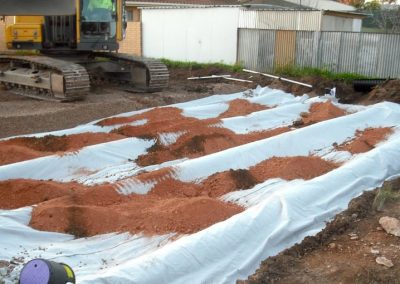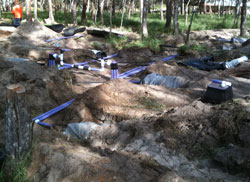Pressure Dosed Alternating Infiltration Trenching
A marked improvement over the conventional trench design.
An improved version of the conventional trench system
These trenching systems can be used in sandy to loam soils (Category 1-3 soils). The system involves a number of trenches being installed for the dispersal of the treated effluent. The top of the trench is typically planted with a lawn grass which uses some of the treated water for evapotranspiration.
The pressurised distribution system allows for the even dispersal of water along the length of the trench (no pooling). It also means that trenches can be dosed with water in an alternating sequence through a distribution valve.
This allows trenches to dry out in between doses which encourages healthy aerobic soil conditions. This in turn helps to maximise the evapotranspiration rate and maintain the soil permeability over time.
The pressure dosed infiltration trench is approved under AS 1547:2012 and is a marked improvement over the conventional trench design.
Provided it is pressure dosed, conventional trenching in category 1-3 soils can be configured to exploit the natural treatment and filtering effect of the biologically active zone of the soil mantle ie the topmost 450mm. There are a number of simple yet advanced pressure distribution techniques including those promoted by Tchobanoglous (2008) and a range of land application system Standard and Guidance Manuals published by the Washington Department of Health that are recommended for category 1-3 soils.
They are also recommended in the Australian and New Zealand Onsite Wastewater Standard AS/NZS1547:2000. These design techniques serve to increase uniformity of flow across the design area and therefore hold up the residence time of the waste stream within the active root zone (rhizozone). This in turn helps to maximise the natural benefits of hydraulic and nutrient outputs achieved from transpiration.
Alternating the wastewater stream over a number of trenches is another design improvement that achieves greater uniformity of flow across the dispersal area to assist in maintaining unsaturated and therefore aerobic conditions within the trench network. This helps to maintain naturally aerobic conditions within trenching system to minimize odour and limit the development of the clogging mat over the soil interface. It also allows time for the soil to recover and re-aerate prior to the next dose.
Unfortunately, conventional trenching is often gravity fed into a singular entry point. This causes permanently saturated anaerobic conditions which leads to an excessive localized clogging (zoogleal) film build up that eventually creeps across the base of the trench leading to early failure. For this reason conventional trenching is not recommended in favour of pressure dosing combined with alternation over a number of proportional networks.
It is further recommended the trenches be deep ripped prior to construction to break up any weathered rock or clay layers and be planted over the top with suitable grasses and ground covers and around the perimeter with non-invasive shrubs and trees. Each of these design features are recognised in the Standard Appendix 4.2A5.6.2 (d,e,f) as measures that improve the ‘long term acceptance rate’ (LTAR) of the soil and thereby protect the integrity of the disposal system. Specifically, appendices 4.2A5.7 and 4.2A6.1 respectively mention that plantings (eg lawn) should always be considered to encourage evapotranspiration to assist in drying out the soil and promote aeration and biological treatment of the effluent and that pressure dose loading ensures even distribution throughout the design area.


